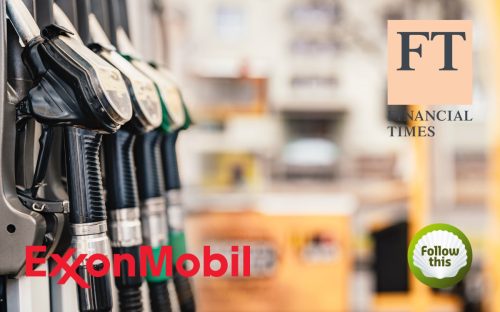INVESTOR BRIEFING
While “Big Oil Braces for Climate Votes as Investor Pressure Mounts” (Bloomberg), investors in Shell are still debating why they should vote in favour of resolution 21, filed by Follow This and ACCR. The votes will be cast this week (Financial Times).
The answer is simple: Shell’s current Energy Transition Strategy (ETS) is not Paris-consistent. Resolution 21 supports Shell to advance its current plans to emission reduction targets and investment levels that are truly Paris-consistent.
As in previous years, Shell will only advance its targets after a substantial percentage of shareholders vote for resolution 21.
We hope you will consider the following facts, before you make your voting decision:
- According to the CA100+ Net-Zero Company Benchmark Shell’s emission reduction targets and investment plans are not Paris-consistent *
- Shell has not committed to a substantial reduction of its absolute emissions by 2030 (graph above) #
- According to Carbon Tracker at least 66% of Shell’s capital expenditure plans are outside a well below 2°C scenario
- According to an in-depth analysis of ACCR Shell does not have any credibility for their reliance on Carbon Capture Utilisation and Storage (CCUS) and Nature Based Solutions (NBS)
- Since Shell’s industry leading announcement on November 28, 2017, when Shell was the first oil major to promise to reduce its Net Carbon Footprint by 50% by 2050, Shell has advanced its promise to 65% (2020), and then to 100% (2021) without setting Paris-consistent intermediate targets and – as a consequence – without shifting investments away from fossil fuels towards renewables
- The latter is shown by the fact that Shells’ Capex is still 97% in fossil fuels: in the period 2016-2020, Shell spent $3.2 out of $106 billion (3%) in renewables (source: NOS, confirmed by Shell (in Dutch)).
Background
Follow This climate resolutions have consistently supported Shell to set Paris-aligned emission reduction targets. Since 2017, Shell has responded to votes for this resolution with new promises for the distant future without shifting investments or reducing emissions.
Shell has made a claim to Paris-alignment since 2018, but has still advanced its targets twice since then after investors supported climate resolutions. Yet again, Shell’s target for 2030 falls short of Paris-alignment. Shareholders need to be clear about red lines to drive reduction in emissions needed and vote for Paris-consistent targets.
Groundhog day for Shell?
This briefing might sound repetitive, while this is the third time Shell urges you to vote against (page 7) this climate resolution, the third time Shell with the same argument that the company has new Paris-consistent plans; and the third time you should vote for.
What does it mean to vote for Shell’s Energy Transition Strategy? (resolution 20)
Shell has also put their own Energy Transition Plan to a vote (resolution 20). Although Shell has taken positive steps in the past years (like including Scope 3), a vote for Shell’s resolution 20 cannot be used as a relative tool to reward their current plan, which is merely less bad than their competitors. We need to set the bar at Paris-aligned emission reductions.
A vote for Shell’s resolution 20 will give them grounds to claim your support for their insufficient climate plan for the next three years. Ultimately, this will mean locking in emissions in the near term that abatement technologies can only do so much to reverse in the far-flung future.
Engagement and voting
The board of Shell has proven only to respond to engagement and voting. We again thank the investors (14.4%) that urged Shell to set advance its targets by voting for in 2020.
During the Follow This investor symposium panelists from institutional investors agreed that oil majors will only act on climate when investors practice strong engagement and vote for climate resolutions.
Oil and gas companies need a clear signal to change course to protect your assets in the global economy from devastating climate change.
# remarks about emission reductions:
- Shell’s carbon intensity target does not translate into a Paris-compliant reduction of absolute emissions by 2030; it could lead to a decrease as well as an increase in absolute CO2 emissions.
- The company has only speculated “We believe carbon emissions from energy sold peaked in 2018” (ETS, page 5).
- According to IPCC-scenarios energy-related CO2-emissions should decrease by 25-45% by 2030 to achieve the goal of the Paris Climate Agreement
- Follow This’ best estimate is that Shell’s production-related absolute emissions could fall by around 10% as a result of the planned decrease in oil production and an increase in natural gas production.
- Shell’s intensity target (20%) falls short of meeting even the lowest requirement of absolute emissions reduction (25%) for keeping temperatures below 2°C.
* CA100+ Net-Zero Company Benchmark
Shell’s scores on four crucial disclosure indicators:
- Long-term emissions reduction target aligned with 1.5°C (indicator 2.3): NO Disclosure Indicator 2 Long-term (2036-2050) GHG reduction target(s), Sub-indicator 2.3. The target (or, in the absence of a target, the company’s latest disclosed GHG emissions intensity) is aligned with the goal of limiting global warming to 1.5°C.
- Medium-term emissions reduction target aligned with 1.5°C (indicator 3.3): NO
Disclosure Indicator 3 Medium-term (2026-2035) GHG reduction target(s), Sub-indicator 3.3. The target (or, in the absence of a target, the company’s latest disclosed GHG emissions intensity) is aligned with the goal of limiting global warming to 1.5°C.
- Short-term emissions reduction target aligned with 1.5°C (indicator 4.3) : NO
Disclosure Indicator 4 Short-term (up to 2025) GHG reduction target(s), Sub-indicator 4.3. The target (or, in the absence of a target, the company’s latest disclosed GHG emissions intensity) is aligned with the goal of limiting global warming to 1.5°C.
- Capital expenditure aligned with 1.5°C (indicator 6,1b): NO
Disclosure Indicator 6 Capital allocation alignment, Sub-indicator 6.1 The company is working to decarbonise its future capital expenditures, Metric b): The company explicitly commits to align future capital expenditures with the Paris Agreement’s objective of limiting global warming to 1.5° Celsius.
Remark: the cut-off date for the benchmark was January 22. Shell announced its new targets on February 11. Nevertheless, these new targets might only change the assessment of the long-term target (2.3) to a ‘yes’. The three other crucial assessments; short-term and medium-term targets and investments (3.3, 4.3 and 5.2); will remain marked with a steadfast ‘no’.
Climate proposal
‘Shareholders support the company to set and publish targets that are consistent with the goal of the Paris Climate Agreement: to limit global warming to well below 2°C above pre-industrial levels and to pursue efforts to limit the temperature increase to 1.5°C.’ full text











